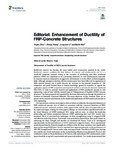Editorial: Enhancement of Ductility of FRP-Concrete Structures
| dc.contributor.author | Zhou, Y | |
| dc.contributor.author | Huang, Z | |
| dc.contributor.author | Li, Long-yuan | |
| dc.contributor.author | Wan, B | |
| dc.date.accessioned | 2021-09-20T13:00:57Z | |
| dc.date.available | 2021-09-20T13:00:57Z | |
| dc.date.issued | 2021-03-05 | |
| dc.identifier.issn | 2296-8016 | |
| dc.identifier.issn | 2296-8016 | |
| dc.identifier.other | 639538 | |
| dc.identifier.uri | http://hdl.handle.net/10026.1/17873 | |
| dc.description.abstract |
Reinforced concrete has become the most widely used construction material in the world. Reinforced concrete combines the best features of concrete and reinforcement and it is a wonderful composite material. Owing to the corrosion of reinforcing steel, fiber reinforced polymers (FRPs) are considered to be a promising alternative to steel reinforcement, especially in concrete structures subjected to an aggressive environment or to the effects of electromagnetic fields. Although attempts to develop effective reinforcement have been followed, the application of FRPs remains limited; this is partly because the variation in the material properties of FRP composites and partly because there is limited knowledge gained by engineers as regards the application aspects of FRP composites and structural mechanics of concrete elements reinforced with FRPs. In order to promote research and applications of FRPs reinforced concrete in civil engineering, a special issue with the research topic of “Enhancement of Ductility of FRP-Concrete Structures” has been proposed and organized by the Guest Editorial team through the platform of Frontiers in Materials: Structural Materials. The main objectives of this Research Topic are to present recent research achievements in the studies and applications of FRPs reinforced concrete in civil engineering. | |
| dc.format.extent | 639538- | |
| dc.language.iso | en | |
| dc.publisher | Frontiers Media | |
| dc.subject | FRP | |
| dc.subject | ductility | |
| dc.subject | composite structures | |
| dc.subject | strengthening | |
| dc.subject | concrete structures | |
| dc.title | Editorial: Enhancement of Ductility of FRP-Concrete Structures | |
| dc.type | journal-article | |
| dc.type | Editorial | |
| dc.type | Journal | |
| plymouth.author-url | https://www.webofscience.com/api/gateway?GWVersion=2&SrcApp=PARTNER_APP&SrcAuth=LinksAMR&KeyUT=WOS:000630334900001&DestLinkType=FullRecord&DestApp=ALL_WOS&UsrCustomerID=11bb513d99f797142bcfeffcc58ea008 | |
| plymouth.volume | 7 | |
| plymouth.publication-status | Published online | |
| plymouth.journal | Frontiers in Materials | |
| dc.identifier.doi | 10.3389/fmats.2020.639538 | |
| plymouth.organisational-group | /Plymouth | |
| plymouth.organisational-group | /Plymouth/Faculty of Science and Engineering | |
| plymouth.organisational-group | /Plymouth/REF 2021 Researchers by UoA | |
| plymouth.organisational-group | /Plymouth/REF 2021 Researchers by UoA/UoA12 Engineering | |
| plymouth.organisational-group | /Plymouth/Research Groups | |
| plymouth.organisational-group | /Plymouth/Research Groups/Marine Institute | |
| plymouth.organisational-group | /Plymouth/Users by role | |
| plymouth.organisational-group | /Plymouth/Users by role/Academics | |
| dcterms.dateAccepted | 2020-12-22 | |
| dc.rights.embargodate | 2021-9-21 | |
| dc.identifier.eissn | 2296-8016 | |
| dc.rights.embargoperiod | Not known | |
| rioxxterms.versionofrecord | 10.3389/fmats.2020.639538 | |
| rioxxterms.licenseref.uri | http://www.rioxx.net/licenses/all-rights-reserved | |
| rioxxterms.licenseref.startdate | 2021-03-05 | |
| rioxxterms.type | Journal Article/Review |


